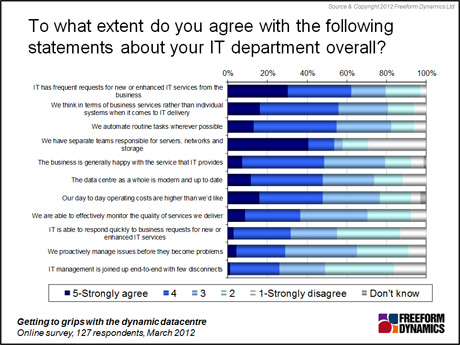The technologies and solutions used in the IT infrastructure have changed dramatically over the years, and will continue to do so for the foreseeable future. Equally, the requirements placed on the IT infrastructure are growing more onerous month by month, and the expectations of business users are continuing to rise.
Why is it then that in many organisations the way IT infrastructure is managed day-to-day often appears to be stuck in a time warp where little has altered over the years?
In the majority of organisations today, the delivery of IT services to users revolves around the central concept of monitoring the individual parts of the underlying IT Infrastructure and reacting to any ‘problems’ that are identified. Core to this approach is the idea that the IT infrastructure itself, and the applications that run upon it, are relatively static, allowing them to be set up and changed only when circumstances alter or attention is required to address faults.
Unless practically unlimited skilled manpower is available, the reactive nature of this fragmented IT management approach places significant demands on the tools that are used to monitor the operational status of systems, and which permit remedial actions to be undertaken. The dependence on management integration to perform daily operations is well represented in our research – yet many companies are dissatisfied with their tools, but don’t invest in them.
As can be seen in Figure 1, IT departments continue to struggle with responding rapidly to business requests for service provisioning. This is less and less acceptable in today’s fast-moving business environment. Which raises the question of whether the traditional IT Infrastructure management approach can carry on without alteration?

Figure 1
In order to make IT Infrastructure management less rigid without costs becoming untenable, ‘cloud’ type approaches – which allow system resources to be shared amongst multiple services – have come into focus. So called ‘private cloud’ systems are frequently based on building virtualised pools of resources, primarily servers, storage and networking. This allows the rapid deployment of business applications and services by adding or removing physical resources as required – for example CPU capacity, memory, storage and I/O, in near real time in response to varying service loads.
In order to move forwards to a more flexible IT infrastructure, CIOs will need to invest time and effort in several areas, some of which may not immediately spring to mind. Figure 2 captures many of the capabilities cited in our surveys as prerequisites for delivering service management in the new world. It is interesting to note that none of the requirements identified are in any way revolutionary, and nearly all of them form the basis for any form of effective management of IT.

Figure 2
Requirements such as a “clear definition of services delivered by IT”, “comprehensive visibility of performance and availability metrics” along with a “clear definition of service level expectations for key services” appear to be so fundamental that it is difficult to see how IT departments manage to get along without having good tools and processes to provide such information. But survey after survey reveals that very few organisations are happy with their capabilities in these areas.
We know that CIOs find it very difficult to get funding for investment in ‘management’ tools, and there is considerable evidence that line of business managers do not understand the linkage between good IT management and the quality of the operations they run every day. CIOs are thus faced with an educational challenge to help their business peers grasp the intimate connection between IT management and the smooth operation of the organisation and improvements to the bottom line.
Given the need to demonstrate ever more effective utilisation and business exploitation of IT systems, it is almost inevitable that the inhibitors highlighted in the bottom half of Figure 2 will have to be addressed. A number of these will have to tackle how to finance IT when users want great flexibility, potentially even combined with making use of external services. After all, it is challenging to get anyone to agree to fund anything unless they are presented with clear evidence of their usage and the knowledge of how their use of IT systems relates directly to business processes.
Running effective IT in a flexible world of demanding users necessitates good management tools, operational processes and sophisticated reporting. Much work remains to be done to get infrastructure management capabilities up to the level they need to be to bring the most value to the business at least cost and risk.
CLICK HERE TO VIEW ORIGINAL PUBLISHED ON
